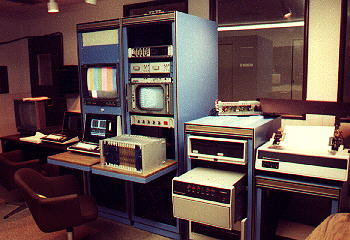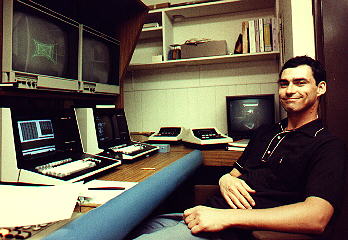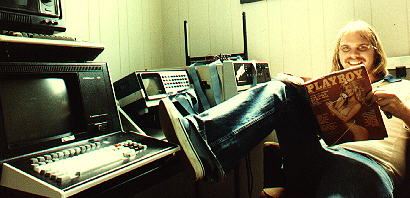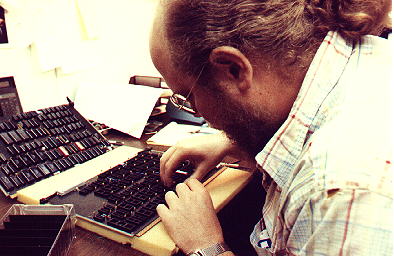 VersEFX: The Early Days
VersEFX: The Early Days
The initial VersEFX Prototype was literally built on proto-logic strips like this.
There was an aluminum rack panel underneath it to act as a ground plane, and
I plugged in multipliers, op-amps, and D/A converters and tweaked them around to
get the desired results.
Shown here is my first 3D rotation matrix.
Rotation sine/cosines came from a D/A board I had built for an Apple ][.
Roy Weinstock wrote a program to control the rotation angles and keyframe them.
We used TV raster sawtooth voltages for the X and Y, and an analog shading
generator or actual video for the Z inputs.
We fed a convergence pattern to the CRT intensity.
This allowed us to demonstrate 3D rotation of a 3D warped grid.
 This system was our mid-level prototype, using a single 68K processor to
control a smaller cage of analog cards shown on the console.
The analog deflection voltages are driving an XY display buried
under the black cardboard to the right, which is being
rescanned by a camera on a tripod.
This sytem was used to debug both the analog and software side
of the 3D rotation matrix operations that allowed VersEFX to
operate in 3D (unlike the 2D Scanimates).
My main regret with this system is that we did not turn it over to our
production people to begin using immediately.
They could have used the technology to do things nobody else was doing
at the time, but we kept holding off for the more complete system....
This system was our mid-level prototype, using a single 68K processor to
control a smaller cage of analog cards shown on the console.
The analog deflection voltages are driving an XY display buried
under the black cardboard to the right, which is being
rescanned by a camera on a tripod.
This sytem was used to debug both the analog and software side
of the 3D rotation matrix operations that allowed VersEFX to
operate in 3D (unlike the 2D Scanimates).
My main regret with this system is that we did not turn it over to our
production people to begin using immediately.
They could have used the technology to do things nobody else was doing
at the time, but we kept holding off for the more complete system....
 This is Jim Ryan, who was the first person to join the project.
Jim's background was aerospace, having designed software systems for Bunker-Ramo.
He developed all the code that ran in the Master and Slave VersEFX systems,
all in Motorola 68000 assembly language.
Jim is shown here at the "interim" console for VersEFX, which had been
an editing console in a former life.
An animation control program allowing 3D rotation, with the 68000 updating
hundreds of registers with new information each frame is running
on the Motorola terminals used with the development system.
This is Jim Ryan, who was the first person to join the project.
Jim's background was aerospace, having designed software systems for Bunker-Ramo.
He developed all the code that ran in the Master and Slave VersEFX systems,
all in Motorola 68000 assembly language.
Jim is shown here at the "interim" console for VersEFX, which had been
an editing console in a former life.
An animation control program allowing 3D rotation, with the 68000 updating
hundreds of registers with new information each frame is running
on the Motorola terminals used with the development system.
 This is Bob Ritchey, our hardware designer, busy at work on the operator
console status display board.
As you can see, Bob could be very studious at times.
Bob had worked at Triple-I on the "MMM", or Movie Machine Memory, which
was a framebuffer used with the F1.
This is Bob Ritchey, our hardware designer, busy at work on the operator
console status display board.
As you can see, Bob could be very studious at times.
Bob had worked at Triple-I on the "MMM", or Movie Machine Memory, which
was a framebuffer used with the F1.
 Here is Roy Weinstock populating one of our custom-designed PC boards.
In all we built some ten different VersaBus boards, of which there were
often many copies to manufacture.
Roy was normally an animator, but because he knew a lot about electronics,
we put him to work in R&D.
Here is Roy Weinstock populating one of our custom-designed PC boards.
In all we built some ten different VersaBus boards, of which there were
often many copies to manufacture.
Roy was normally an animator, but because he knew a lot about electronics,
we put him to work in R&D.
All images Copyright © Dave Sieg
Back to Dave's History Page
Please email me for more info: dave@zfxinc.net